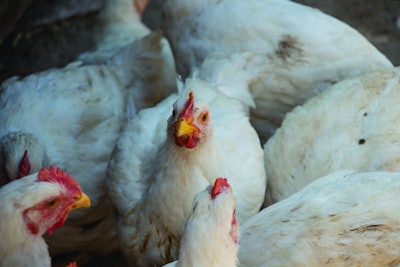
Surface wetting by sprinklers in the poultry house can help broilers sustainably and efficiently better cope with the warm weather that leads to heat stress.
“Heat stress is one of the most challenging stressors to poultry production, with a strong adverse effect on welfare and production,” Yi Liang, associate professor of biological and agricultural engineering and faculty with the Center of Excellence for Poultry Science within the University of Arkansas System Division of Agriculture, said during the 2023 Georgia Precision Poultry Farming Conference.
Heat stress occurs when birds have difficulty balancing between body heat production and heat loss, in other words, their natural coping mechanisms under warm conditions are no longer able to combat heat.
For broilers, that natural coping mechanism is panting. However, heavy panting can quickly tire a bird out, especially in high humidity. This can slow the growth rate of a broiler.
Surface wetting by sprinklers
There are several approaches producers can take to cool down poultry during warm weather.
Tunnel ventilation removes bird heat from the house through air exchange, removing the boundary of hot air surrounding the poultry. One advantage of this system is that it removes the humid air, making panting more efficient as a way of cooling down.
Evaporative cooling cells are another way. These aim to lower air temperature and promote sensible heat loss for the birds. However, these often lead to an increase in relative humidity as well, which can increase the risk of heat stress.
The third approach is surface wetting.
Low-pressure sprinkler technology, also known as surface wetting technology, relies on a water regulator to maintain pressure between 30 and 50 psi. Using nozzles spaced evenly through the house, the system creates artificial rain made of coarse water droplets that cools the surface of the chicken.
The sprinklers provide direct cooling for the birds through intermittent spray. A temperature sensor in the poultry house controls the frequency (typically between 10 and 30 minutes) and the duration of each spray (typically between 20 and 40 seconds).
“There are several advances to using sprinkler cleaning, including water conservation, potentially dryer litter conditions and we can also maintain production performance,” explained Liang, who also conducts research at the Arkansas Agricultural Experiment Station, the research arm of the University of Arkansas System Division of Agriculture.
In addition, sprinkler cooling is highly sustainable, consuming approximately 64% less water than used in a conventional cool cell cooling system.


















